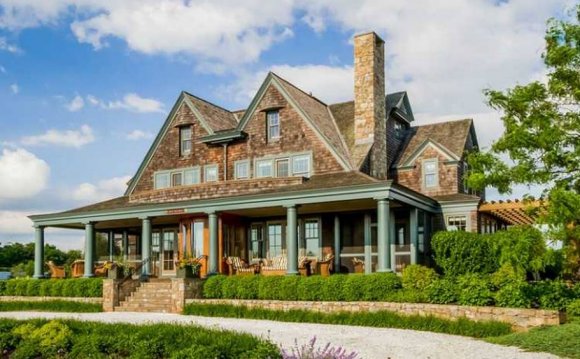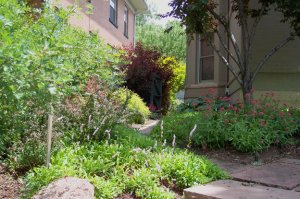
To coincide with National Historic Preservation Month, on May 19th, Art of the Land Principal and Founder, Nancy Eastman spoke to guests of the Loveland, Colorado Historic Preservation Commission. Audience members were primarily owners of older and historic homes in the area, interested in designing an appropriate landscape, selecting the right style and plants, and maintaining a restored landscape. Following is a summary of that presentation.
For further information, and for assistance in your own historic landscape planning, contact Art of the Land.
Of course, through history, landscape design styles have evolved both to please the eye, and, earlier, to feed the family. From parks to cottage gardens, styles moved from Old World to New, and, eventually further West to Colorado. Here, there really was no single “style” of garden. A mix of styles and uses ran parallel to the mix of people migrating here and dealing with our particular climate.
Eventually, parks, cemeteries and, even, parkways were created with landscape design considerations. Larger homes were constructed, and the wealthy started to express their personal tastes and preferences through their gardens. In urban areas, these gardens were primarily providing relaxing areas for friends and family.
Following World War II, however, the pace of design and style change proceeded more rapidly, spreading to more and more houses of all sizes, growth into new areas, and the use of natural resources such as rock and water. Just knowing a little about landscape design history can help you determine a historically appropriate design for your home.
Determining the Appropriate Historical Style
Many resources exist to assist you, and the internet has made finding many of them much simpler. Look for old photos, books, documents and landscape plans. Your regional Botanic Gardens is always a good source for historical material. And, the local garden centers and nurseries that have been around for a while usually know their history.

If your home is in or near an established Historic District, there may already be some rules or guidelines for appropriate landscape treatment. Here, in Loveland, there has been a Historic Preservation Ordinance since 2002. The Loveland Register of Historic Places lists 65 structures, and the city has three Historic Districts. Check with the Preservation Commission for resources.
Check out the neighbors! Tour your area to find structures of similar age and architectural style, and see what ideas their landscapes provide for your situation. Older parks, cemeteries, old parkways and gardens are good places to get ideas.
Consider more historic features like fences and walls in period style, pergolas, grape arbors and other structures. And, consider including the older, larger trees that may date from your home’s original construction.
Historically Appropriate Plants
As we suggested, earlier gardens and landscapes emphasized food production with fruit, berries and vegetables playing major roles. Jellies, jams, pies, preserves and wine came from the garden. Popular were cherry, apple and plum trees, raspberries, currants, gooseberries and grapes. Vegetables were grown in typically rectangular beds, smaller versions of the family farm, typically potatoes, cabbage, onions and squash.
Kitchen gardens evolved later and in design, as well. Some are actual central features of an ornamental, all-season landscape, structured and based on repetitive geometric patterns. Many have year-round visual appeal and incorporate perennials or woody plantings. Often, they contain herbs like rosemary, basil and chives, and, even, medicinal herbs.
Lawns began as mowed or grazed pastures, evolving to non-productive luxury spaces. Windbreaks were used to protect orchards and crops.
Pleasure plants included shade trees, deciduous shrubs and lots of perrenials. Native here are Colorado Blue Spruce and Rocky Mountain Juniper. Other shrubs are Serviceberry and Chokecherry. Perennials like Bearded Iris, Bleeding Hearts, Peonies and Lilies do well, also.
Old plants are easily researched at the Denver Botanic Gardens and Colorado State University Extension Service. The Denver Rose Society is another good resource for front range gardeners, as are specialized plant and seed catalogs dealing in pioneer and heirloom plants. And, of course, research the “queen” of the cottage garden, Gertrude Jekyll who published books and hundreds of articles in the late 19th and early 20th century.
Historic Landscape Style
You’ll want to design appropriately for the mood, or architectural style of your residence. Is it European – English, French, Italian? Do you want a formal or informal look? Is your location practical, and are you trying to frame a particular view? What is your desired overall color or texture outcome? And, consider the place – rural or urban.
The Cottage Garden style, originating in England has been popular for a long time. It features “full” spaces, large beds fo bright, colorful flowers for cutting and elements of art and statuary.
A Final Consideration and Conclusion
A lot of new approaches to gardening and landscape design have come along. And, depending on your property, it may actually be better to take a more modern approach. Styles change. Water use goals change. And, as always, your landscape does affect your property value and your property’s perception in the community. Choose carefully as some plants have been overused and may not be as popular now. Some older plants that were frequently used are now considered undesirable and may even be prohibited in some areas. Examples are Siberian Elms and the Russian Olive.
New and improved plants and varieties have been bred to reduce problems with disease, water use, and, even insect pests.
Many, many sources of information are available through your own research and local historic organizations. And, keep in mind, there are many valid approaches… and it’s always best to start with a comprehensive design drawing. Your design will become a part of history itself!
RELATED VIDEO












